

| The Sherwood Forest Rothamsted survey results |
| Between 1982 and 1990, a Rothamsted light trap was run at the former Sherwood Forest Visitor Centre. Such traps were located at a number of sites across the UK and situated in a variety of habitats. Around 80 Rothamsted light traps are still in operation today, all forming part of the Rothamsted Insect Survey (RIS) which has been running two trap networks (the other being a suction trap rather than a 200w clear tungsten filament light) since 1964. |
| ... |
| The survey's long term data is unique, providing data on aphids,
larger moths and migrating insects to scientists, commercial growers and
conservation organisations etc. For more information on the survey,
visit their website at
www.insectsurvey.com Although the RIS website shows that the Sherwood trap was run between 1982 and 1990, the only results we were given by staff at the Country Park were from 1986 to 1990. But I don't think even they had the results of 1982 to 1985. Indeed, it wasn't until the research stage prior to writing this article, that I found there was actually three years missing. With the atrocious non-keeping and/or complete lack of interest in those invertebrate records sent in by members of the public, organisations and an assortment of invertebrate surveyors, who knows where they ended up? |
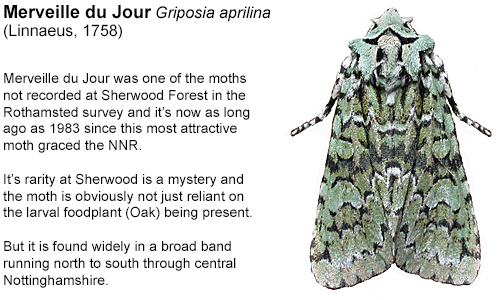 |
|
| ... | ||
|
We were only ever given a pile of various scraps of paper from which we
wanted to create a series of species lists. The papers were often mixed
and sometimes just scribbled notes on small scraps of notepaper. The Sherwood Forest invertebrate records and the Rothamsted records Many records were useless, sometimes even barely descriptive of species and as many had no site name or location, they might have well come from China! That there was no species list for our local National Nature Reserve (NNR) surprised us, especially with Sherwood being branded by Natural England as such a marvellous and special site ... which it is, but to have no easily accessible species list in a digital format, was dumbfounding to be honest. |
||
| ... | ||
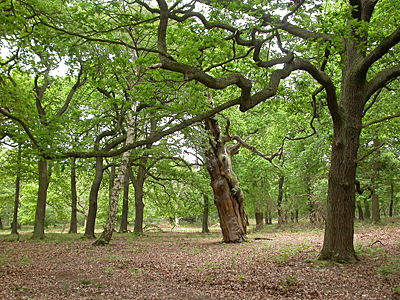 |
So after a whole Winter spent sorting through records, going through
several thousand individually to assure we had the latest genus, family
and scientific categorisation and name for each species, we eventually had a workable list
for most invertebrate orders in place. These lists are in the process of
being updated when I can find the time, but its a lengthy
process. Among the pages of records we were given, were the larger moth
totals resulting from the Rothamsted survey between 1986 and 1990. These
of course, were incorporated into the Lepidoptera list, but they were
always felt to be a useful topic in their own right. The trouble with records and sending records in, is that that's usually the end of them. Once they have left your PC, laptop or whatever, records have the habit of vanishing, rather than being fed into a national recording scheme and ultimately ending up on the NBN Atlas, where others have access to them and where all records should end up in my opinion. So rather than have the original copy of the records and information which follows, gaining dust (if they still even remain since they were returned) and lying unread in an office cupboard, I've decided it was about time to publish them and to briefly summarise the changes in species status within Sherwood Forest. |
|
| .... | ||
|
A period of regular recording using 125W MV lights by Dilys and myself, David Hursthouse, Iain Leach, Kate Harte and Paul Baker between 2008 and 2015, are responsible for a number of species increases within the NNR and also an increase in the number of records shown by many species since the Rothamsted survey ended in 1990. But less obvious changes at Sherwood Forest - such as the surge in Lichen growth on trees within the Forest, which (although never documented officially) was thankfully noted and remembered by former Ranger Andy Borroff. At the time and even now, Andy is still hands down, the most knowledgable person to walk among Sherwood's ancient Oaks. The increase in Lichen growth coincided with the Most of the factors affecting Sherwood's moths in a negative manner, probably didn't really affect anything over the duration of the survey and have likely only just started to have an effect in more recent years. Back in the 1980's and 1990's there was really no site management plan authorising the removal of non-native species and even those trees which were actually native to the forest and it's healthland sites, but just deemed to be either in the way, or the fact that there were just too many of them! The other (almost compulsory factors today) such as climate change, habitat loss and deterioration of habitat for particular species, don't come into play here at the time. The effects of climate change, were still just largely the topic of conversations between scientists and climatologists and not really becoming evident until after the survey had ended at Sherwood Forest. Management then, of what is now the NNR, was not on the damaging scale many of us think it is today. Survey data The following tables shouldn't need any interpretation from myself, as they should be pretty self-explanatory. The data and numbers are as that we were originally given by staff at the Sherwood Forest Visitor Centre a number of years ago. In all, a total of 10,032 moths were trapped and it is believed that the majority of these were killed on entering the trap. 10,000 plus moths is a huge total to remove from a habitat and while there seems to be little evidence to show five years of trapping had a huge impact on Sherwood's moth populations, one should wonder that at what the cost has it to be before we consider surveys like this to be legitimate, especially given that not all a site's invertebrate populations are large enough to be able to absorb heavy losses. Breeding species lost from Sherwood Forest since the survey There are a number of species which have subsequently been lost as definite breeding species, since the end of the Rothamsted survey in 1990. The following fall into this category (with their last year of occurrence) which to the best of my knowledge and the data available to me, have not been recorded since:- Agrochola lychnidis Beaded Chestnut in 1987, Trichiura crataegi Pale Eggar, Eulithis mellinata Spinach, Eupithecia icterata subfulvata Tawny Speckled Pug, Diaphora mendica Muslin Moth and Apamea unanimis Small Clouded Brindle in 1990. |
||
| Hepialidae summary Its quite interesting that both Phymatopus hecta Gold Swift and Hepialus humuli Ghost Moth were not recorded during the survey, but the siting of the trap away from the typical habitat usually associated with both species could have been a contributing factor. Ghost Moth remains generally uncommon at MV light across the Sherwood Forest NNR and is traditionally best found by searching areas of short grass at dusk. |
||
| ... | ||
| Cossidae and Zygaenidae summary Both species from these two Families occurred during the survey. Zeuzera pyrina Leopard Moth has always remained a rare moth at Sherwood and to date there are still just five records, with three of these occurring since 2006 and personally its a mystery to why a day-flying species such as Zygaena lonicerae Narrow-bordered Five-spot Burnet was ever included in the Rothamsted survey list. Even rarer than Leopard Moth with just two Sherwood Forest records in 1982 and 1983, it remains common across Nottinghamshire. Drepanidae summary Huge numbers of Achlya flavicornis Yellow Horned trapped were representative of a commonly occurring moth. Fortunately, this remains so and it is very common at light in the Sherwood Forest CP early in the year. Both Watsonalla cultraria Barred Hook-tip and Habrosyne pyritoides Buff Arches, never turned up in the Rothamsted trap between 1986 and 1990, but have occurred since, with the former species being recorded as new to Sherwood Forest in 2008 (Wright, S. and Osborne, J.E.) while Buff Arches was recorded for only the second time at Sherwood in 1986, with an increase in occurrences since 2008. |
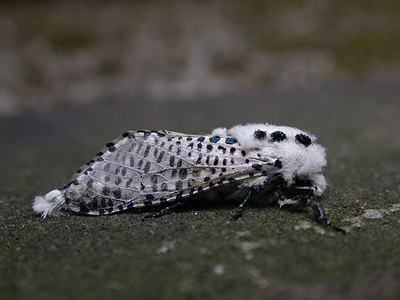 |
|
| ... | ||
| Just one record of Oak Hook-tip is surprising as it remains more or less annual in small numbers, while Falcaria lacertinaria Scalloped Hook-tip, which proved commonest of the Hook-tips remains so today. Of the remaining Drepanidae, the various cumulative totals are quite indicative of their present day numbers, although Thyatira batis Peach Blossom has showed a small increase. | ||
| Fig 01. Hepialidae, Cossidae, Zygaenidae, Drepanidae and Lasiocampidae species producing their last ever records at Sherwood Forest during the survey | ||||
| ... | ||||
| Last recorded | Only NNR record Y/N | |||
| Trichiura crataegi Pale Eggar | 1990 | N | ||
|
Lasiocampidae summary Lasiocamidae are not particularly well represented in modern day Nottinghamshire, although one moth which would have been expected to be on the list of recordable species Lasiocampa quercus Oak Eggar, has become increasingly common within the county and in the Sherwood Forest NNR area, when prior to 2009 there had been just a solitary historical record. High counts of Poecilocampa populi December Moth would certainly be produced if the trap was still in existance today, but Euthrix potatoria Drinker is one moth which has seemingly increased at Sherwood Forest since 1990, frequently appearing in good numbers at MV light. |
||
| ... | ||
 |
On a more downbeat note, the
Sherwood Forest NNR's last
records of
Trichiura
crataegi Pale Eggar all came during the
survey while
Malocosoma neustria
Lackey has not been recorded in the Sherwood
Forest area since an isolated record back in 1982 and still remains
only an occasionally recorded species in the county overall. Sphingidae summary The lack of Sphingidae (Hawk-moths) is stunning for anyone who has ever regularly trapped at any site within the Sherwood Forest NNR. Out of the five listed species, the only records were of single Laothoe populi Poplar Hawk-moth in 1988 and 1990. While Mimas tiliae Lime Hawk-moth has been recorded sporadically on a number of occasions and Smerinthus ocellata Eyed Hawk-moth even less often (last NNR record from Sherwood Heath in 1994) the non-appearance of both Deilephila elpenor Elephant Hawk-moth and Deilephila porcellus Small Elephant Hawk-moth during the survey would suggest recent increases. Both species produced few NNR records prior to 2000 and must have been under-recorded prior to this, although Small Elephant Hawk-moth has always been the less common of the two. |
|
| .... | ||
| Elephant Hawk-moth is very common now and will often arrive at MV light in numbers, but it was always a common moth in Nottinghamshire and certainly has been since the 1970's, when my own interest in moths began. Sphinx pinastri Pine Hawk-moth was not included in the list of species, but would certainly be the second most commonly recorded Hawk-moths today, even with the recent large-scale removal of commercially grown Pines. | ||
|
Geometridae summary Many of the largest counts from the Sherwood Forest Rothamsted data came from this Family. Coming up are all those species with totals over 200, which illustrates that the Sherwood Forest area contained healthy populations of these species at the time of the survey. But today, it is difficult to look at the results in a more positive manner, knowing that all these moths were killed. Although many naturalists may steadfastly insist that removing a few hundred individuals from any healthy population, will do no long term harm, from a more modern ethical viewpoint, it cannot be considered suitable practice today and certainly doesn't sit well with myself personally. |
||
| ... | ||
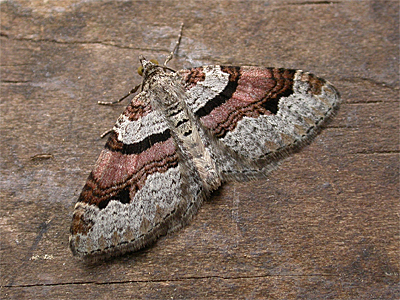 |
The 200+ counts included a massive 801
Petrophora
chlorosata Brown Silver-line, with over
50% of these trapped in 1986, 726
Operophtera
fagata Northern Winter Moth, 402
Xanthorhoe
montanata Silver-ground Carpet, 244
Idaea biselata Small
Fan-footed Wave and 230
Epirrita
dilutata November Moth. Thankfully all
these moths are still to be found in good numbers at Sherwood Forest
today. Ten other species also produced three figure counts during the survey, of which 184 Idaea aversata Riband Wave and 180 Alsophila aescularia March Moth. Both moths are still extremely common at MV light across the Sherwood Forest NNR. But while some species were recorded in large numbers over the survey's five years, there were non-appearances by many species. Some 23 listed Geometrids weren't trapped between 1986 and 1990, but a number of these have gone on to be recorded regularly, or almost annually since the survey. Both Scotopteryx chenopodiata Shaded Broad-bar and Xanthorhoe designata Flame Carpet (left) are two typical examples turning up at MV light on a number of occasions, although neither species could ever be called common at Sherwood Forest. |
|
| ... | ||
| The Pine/Spruce reliant Pennithera firmata Pine Carpet, Thera britannica Spruce Carpet and Thera obeliscata Grey Pine Carpet, have long been known from the Sherwood Forest NNR, but all three were not recorded during the Rothamsted survey. This may have been due to the siting of the trap being within Oak/Birch woodland, but there were Pines located not too far away so they would have been expected. All three are still present in the Sherwood Forest NNR (mostly in the Budby South Forest and Clipstone Old Quarter areas, but have never been recorded regularly from within the confines of the Country Park. | ||
| ... | ||
|
Rhodometra
sacraria Vestal is a regular migrant to southern
counties of the UK, occurring in Nottinghamshire as an occasional
migrant in small numbers and not annually. It has never been
recorded from Sherwood Forest. Non-appearances of both Eulithis prunata Phoenix and Eulithis populata Northern Spinach, were not surprising, as there have been no records of either species since 1981 and only recorded prior to that as single historical records by R.E. Brameld. Eulithis testata Chevron is a surpringly uncommon (even rare) moth anywhere in Sherwood Forest, with just a single record from the heathland of Budby South Forest since 1981. Chloroclysta siterata Red-green Carpet has become increasingly well recorded in Nottinghamshire and more locally throughout the Sherwood Forest NNR since 1987. At Sherwood, it has been more or less annual since 2004, but it was not recorded during the survey. Neither were Epirrita filigrammaria Small Autumnal Moth which was recorded historically and then again in 1987 (but seemingly not in the survey trap), Philereme transversata Dark Umber and Perizoma affinitata Rivulet which both remain scarce moths anywhere in the Sherwood Forest NNR. |
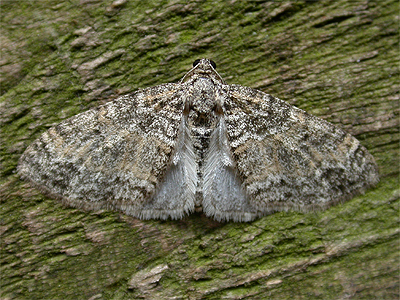 |
|
| ... | ||
|
Finishing off those species not recorded during the Rothamstead
survey, are a number of moths historically uncommon or rare at
Sherwood Forest anyway.
Aplocera
efformata Lesser Treble-bar
and
Lobophora
halterata Seraphim have always been
rare, but both species were recorded prior to the survey in 1983 and
have turned up as single records since, while
Abraxas sylvata
Clouded Magpie has occurred on just one
occasion (Finch, G. and Finch, A.) back in 1986 and away from the
Country Park. Rhodometra sacraria Vestal is a regular migrant to southern counties of the UK, occurring in Nottinghamshire as an occasional migrant in small numbers and not annually. It has never been recorded from Sherwood Forest and was another species which unsurprisingly failed to turn up. As was the day-flying Archiearis parthenias Orange Underwing, which is common enough in the early Spring, when it is often seen fluttering around the tops of Birches, but does come down to drink from muddy puddles. Semiothisa clathrata Latticed Heath is another moth regularly encountered during the day, but much less so than the often abundant Ematurga atomaria Common Heath, so it was no real surprise to find these three moths unrecorded. |
||
| ... | ||||
| Fig 02. Geometridae producing their last ever records at Sherwood Forest during the survey | ||||
| ... | ||||
| Last recorded | Only NNR record | |||
| Scopula ternata Smoky Wave | 1987 | N | ||
| Scopula immutata Lesser Cream Wave | 1989 | Y | ||
| Scotopteryx mucronata Lead Belle | 1987 | N | ||
| Scotopteryx luridata July Belle | 1987 | N | ||
| Xanthoroe spadicearia Red Twin-spot Carpet | 1988 | N | ||
| Epirrhoe rivata Wood Carpet | 1986 | N | ||
| Epirrhoe galiata Galium Carpet | 1987 | Y | ||
| Pelurga comitata Dark Spinach | 1987 | N | ||
| Eulithis mellinata Spinach | 1990 | N | ||
| Lampropteryx otregiata Devon Carpet | 1986 | Y | ||
| Epirrita christyi Pale November Moth | 1989 | N | ||
| Epirrita filigrammaria Small Autumnal Moth | 1987 | N | ||
| Venusia cambrica Welsh Wave | 1988 | Y | ||
| Eupithecia tenuiata Slender Pug | 1986 | N | ||
| Eupithecia pusillata Juniper Pug | 1986 | N | ||
| Eupithecia lariciata Larch Pug | 1986 | Y | ||
| Eupithecia innonata fraxinata Angle-barred Pug | 1988 | Y | ||
| Eupithecia trisignaria Triple-spotted Pug | 1988 | N | ||
| Eupethicia assimilata Currant Pug | 1990 | Y | ||
| Eupithecia icterata subfulvata Tawny Speckled Pug | 1990 | N | ||
| Abraxas grossulariata Magpie | 1986 | Y | ||
| ... |
|
Summarising the last of the unrecorded Geometrids before dealing
with the various Pugs, are a number of species which have never been
regular at Sherwood Forest. Epione repandaria Bordered Beauty doesn't breed within the Sherwood Forest NNR, but has turned up on odd occasions. Ennomos quercinaria August Thorn, is another rare moth which has only been recorded a few times, the last being from Budby South Forest in 2010 (Hursthouse, D. et al). Ennomos fuscantaria Dusky Thorn, is common locally, but not at Sherwood Forest. Not turning up during the survey was no real surprise as Ash (the larval foodplant) doesn't occur in the NNR, yet it is a regular wanderer to garden traps operated within a few miles away. Hylaea fasciaria Barred Red is fairly regularly recorded at Sherwood Forest (especially post-2000) so not entirely surprising that it did not turn up during the survey, but it was surprising that Perconia strigillaria Grass Wave failed to show, though this may have been down to the location of the Rothamstead trap. Geometridae summary (Pugs) Some 25 species of Pug were recorded during the Rothamsted survey. To be honest, it is quite a list for any single trap site. Apart from 158 Eupithecia vulgata Common Pug and 23 Eupithecia abbreviata Brindled Pug, the remaining 23 species were only recorded in very small numbers and many of these were just single occurrences over the five years worth of data we have available from when the trap was run. Pasiphila chloerata Sloe Pug, was the only listed Pug not to be recorded during the survey and the following species were only recorded as singles in the five years of the trap's operation. Chloroclystis v-ata V-Pug, Eupithecia tenuiata Slender Pug, Eupithecia tripunctaria White-spotted Pug, Eupithecia virgaureata Golden-rod Pug, Eupithecia lariciata Larch Pug, Eupithecia simpliciata Plain Pug, Eupithecia nanata Narrow-winged Pug, Eupithecia indignata Ochreous Pug and Eupithecia centaureata Lime-speck Pug. V Pug, Golden-rod Pug and Lime-speck Pug have become more regular in recent years but White-spotted Pug, Larch Pug and Plain Pug all remain rare. Narrow-winged Pug is abundant on the heathland locally and would have been expected to occur more than just once in the survey. |
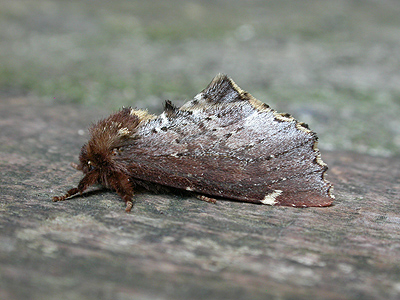 |
Notodontidae and Erebidae summary For some reason, there was a real 'no show' for many of the Prominents. With the exception of Drymonia dodonaea Marbled Brown, which has not been recorded at Sherwood Forest since 1964, all of the listed Notodontidae would certainly have been expected, had the trap been operated in the last five years. Furcula furcula Sallow Kitten, has only been recorded at Sherwood Forest regularly since the onset of regular trapping in 2006, with just a single 1983 record from Budby South Forest prior to this. Notodonta dromedarius Iron Prominent and Ptilodon capucina Coxcomb Prominent remain two of the commoner members of this Family, with Notodonta ziczac Pebble Prominent, Pheosia tremula Swallow Prominent and Pterostoma palpina Pale Prominent all being less than annual. On the basis of the trap counts between 1986 and 1990, Drymonia ruficornis Lunar Marbled Brown and Pheosia gnoma Lesser Swallow Prominent have both showed increases in numbers. And despite it's name, Odontosia carmelita Scarce Prominent (left) isn't that scarce, being regularly attracted to MV light in season. |
|
| ... | ||
| Largest of the Notodontidae and Erebidae counts were pretty much as would be expected. 306 Spilosoma lutea Buff Ermine, 120 Eilema lurideola Common Footman, 66 Hypena proboscidalis Snout and 45 Spilosoma lubricipeda White Ermine. All four species remain common to light and would probably produce similar counts today. |
|
There were no records of
Scoliopteryx
libatrix Herald, which is uncommon at
Sherwood and more easily recorded as larvae on the young growth of
Goat Sallow Salix caprea, growing along forest tracks.
Catocala nupta Red
Underwing is a rarely recorded moth anywhere within
the Sherwood Forest NNR. This is purely down to the lack of larval
foodplant, so it was no surprise to not see it turn up in the
survey. Similarly Arctia caja Garden Tiger was another unrecorded moth. Declining across Nottinghamshire for many years, it's surprising that there is only a single Sherwood Forest record, dating from way back in 1954. Personally I don't see why two day-flying moths were incorporated into the list, so not unsurprisingly, there were no records of either Euclidia mi Mother Shipton or Orgyia antiqua Vapourer, although males of the latter are not unknown at light, they are mostly diurnal fliers. Mother Shipton remains local in the area, occurring in small discreet colonies in a few dry grassy areas. |
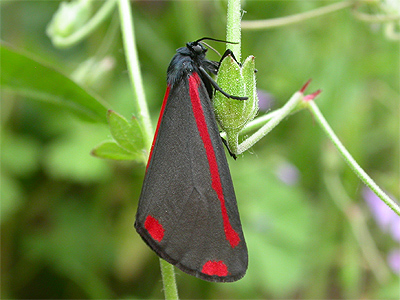 |
|
| Despite non-appearences between 1986 and 1990, the following species have all gone on to become increasingly common. Not known from Sherwood Forest until as recently as 2005, Rivula sericealis Straw Dot could be considered to be almost abundant some years. Straw Dot's increase has also been noted county wide, as has the following three species. |
| Fig 03. Erebidae producing their last ever records at Sherwood Forest during the survey | ||||
| ... | ||||
| Last recorded | Only NNR record Y/N | |||
| Diaphora mendica Muslin Moth | 1990 | N | ||
|
Eilema depressa
Buff Footman was recorded new to Sherwood Forest
NNR in 2007,
Eilema griseola
Dingy Footman (just a single 1983
record prior to becoming annual from 2007) and
Eilema complana
Scarce Footman, which was recorded on
two occasions in the late 1800's, but then not again until 2006 when
records became annual. It's quite interesting that of all the
Footman moths, only Eilema
lurideola Common Footman was recorded during the
survey, with a total count of 120 moths trapped over the five years,
but with a strangely blank year in 1989. The larvae of all four
Footman species are lichen feeders and if you know the old trees of
Sherwood Forest, you should already be aware that they are liberally
covered in various Lichens. But this hasn't always been the case.
Not too long ago (around 35-40 years) there was minimal Lichen growth on Sherwood's trees, but following the UK Government's 1993 Clean Air Act (a consolidation of the 1956 and 1968 Clean Air Acts) the conversion of houses from coal fired to gas central heating and the closure of the Collieries, ultimately led to considerably better air quality, allowing Lichens to flourish. Ultimately, this led to increases in the ranges of Buff, Dingy and Scarce Footman. |
|
Noctuidae summary
The Rothamsted trap produced a total of 98 different Noctuids over the five years the trap was in operation. 40 of those listed on the species list we were given were not recorded during the survey, although in a few instances this wasn't perhaps surprising due to either their previous rarity in the area, or their rarity at Sherwood Forest through the 1980's and 1990's. Grey Shoulder-knot was not even known from VC56 Nottinghamshire until 2003 and Blair's Shoulder-knot did eventually turn up at Sherwood, though not until 2008. Three wetland species, namely Nonagria typhae Bulrush Wainscot, Arenostola phragmitidis Fen Wainscot and Lenisa geminipuncta Twin-spotted Wainscot have all proved rare at Sherwood, but wanderers do occur well away from suitable habitat. Bulrush Wainscot has only been seen at Sherwood Forest on two occasions, the last being as long ago as 1967, while Fen Wainscot was recorded in 1975 and then again at Clipstone Old Quarter in 2013. Lastly, Twin-spotted Wainscot was only recorded at Sherwood for the first time in 2008, but there have been additional records in 2009 and 2013. |
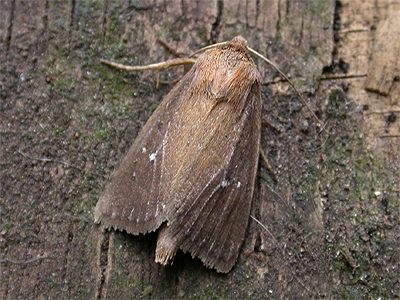 |
|
|
Even before the survey started, Actebia praecox
Portland Moth had already been extinct for a
number of years from it's last known site at Budby South Forest,
where it was last recorded in 1975. It hasn't been
recorded since and is hardly ever likely to be. But among the moths fitting in the category of being rare at Sherwood Forest, both before and during the survey, were some very common species. Now it might be that the reason for an increase in records and change of status, stems from the regular recording at Sherwood Forest CP by a number of recorders from 2008 onwards. Plusia festucae Gold Spot went from only occurring at Sherwood Forest twice before the survey, to being more or less annual from 2009. Similarly, Tiliacea aurago Barred Sallow is another, with consecutive records in 1982 and 1983, but then nothing until it proved to be more common from 2009. But there are a trio of very common moths, who's absence from the five year survey is something of a mystery. Mythimna conigera Brown-line Bright-eye and Mythimna pallens Common Wainscot appear (from the records) to have been regularly recorded both prior to (and after) the survey. There are records of both species during the period of the Rothamsted survey and I think that at some time, errors in the yearly totals have somehow crept in. Anarta myrtilli Beautiful Yellow Underwing, is a bit of another mystery, with just two historical records from the entire NNR, until it seems to have suddenly reappeared again in 2006. It is abundant in all heathland areas within the Sherwood Forest NNR and common at other heathland sites locally, but it's absence is probably due to it being diurnally active rather than nocturnal. |
||
|
Among the long list of
those species unrecorded during the Rothamsted survey were Abrostola triplasia
Dark Spectacle,
although Dark Spectacle is by no means a common moth in Nottinghamshire
and is rarely reported, but
Diachrysia
chrysitis Burnished Brass and
Protodeltote
pygarga Marbled White Spot have both
become commoner post-2000, but
Autographa jota
Plain Golden Y is still a rarity
anywhere in Sherwood Forest.
Acronicta
aceris Sycamore is new to Sherwood,
being recorded on three occasions since first appearing in 2008,
while
Subacronicta
megacephala Poplar Grey and
Amphipyra
berbera Svenssons Copper Underwing are
still relatively uncommon and infrequently recorded. No surprise in not turning up during the survey was Acosmetia calignosa Reddish Light Arches, which has not been seen here since 1975. Even rarer is Apamea epomidion Clouded Brindle, with no further records since a single historical record by Brameld. Lateroligia ophiogramma Double Lobed is really out of habitat at Sherwood and has only been recorded once, the last time being back in 1982, by better news concerning Litoligia literosa Rosy Minor, which has been recorded three times since 2008. |
||
| ... | ||
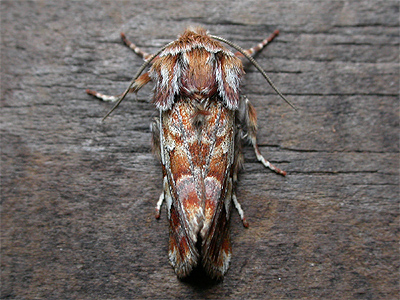 |
To conclude the summary of those species not recorded during the
survey are the following species. Cirrhia gilvago
Dusky-lemon Sallow is very rare in Nottinghamshire
and there remains just three Sherwood Forest records, the last coming in
1983. Conistra rubiginea
Dotted Chestnut was only recorded in the county
for the first time in over 100 years in 2019, but has never occurred at
Sherwood Forest.
Ipimorpha
subtusa Olive remains very rare with
only two records prior to the survey, but was recorded from Budby South
Forest in 2011, while there remain just two records of
Atethmia
centrago Centre-barred Sallow. Griposia aprilina Merveille du Jour was last recorded in 1983 and despite being widely recorded across the county, does not occur regularly at Sherwood Forest, despite it being largely Oak woodland. Antitype chi Grey Chi has produced only one 1975 record, but Aporophyta lutulenta Deep Brown Dart is more regular although still rarely recorded. Hadena bicruris Lychnis, was another species not to turn up, producing no records since 1976. Euxoa nigricans Garden Dart appears to have declined in recent years and may not occur in the NNR at all now, while Agrotis clavis Heart & Club and Agrotis vestigialis Archer's Dart are extremely restricted in the county. |
|
| ... | ||
| Fig 04. Noctuidae producing their last ever records at Sherwood Forest during the survey | ||||
| ... | ||||
| Last recorded | Only NNR record Y/N | |||
| Abrostola triplasia Dark Spectacle | 1987 | N | ||
| Diloba caeruleocephala Figure of Eight | 1986 | N | ||
| Apamea unanimis Small Clouded Brindle | 1990 | N | ||
| Agrochola lychnidis Beaded Chestnut | 1987 | N | ||
| Euxoa nigricans Garden Dart | 1990 | N | ||
| Naenia typica Gothic | 1988 | Y | ||
|
Lycophotia
porphyrea True Lover's Knot has
increased enormously in recent years, but was known from the area
before the Rothamsted survey. Rhyacia simulans
Dotted Rustic is unknown from Sherwood Forest, but
Noctua
interjecta Least Yellow Underwing would
have been expected to have occurred. Both Spaelotis ravida
Stout Dart (no records since 1981) and Xestia ditrapezium
Triple-spotted Clay
(no records since 19870 are real rarities here, while the migrants
Peridroma
saucia Pearly Underwing has only ever
been recorded twice at Sherwood Forest, but
Agrotis ipsilon
Dark Sword-grass (by far the more
regular migrant of the two) has turned up regularly in favourable
years since the survey. At the other end of the scale, 13 species were recorded just the once. Colocasia coryli Nut-tree Tussock turned up in 1987 and is now common, while there have been no further records of Diloba caeruleocephala Figure of Eight since it was last recorded in 1986. |
| ... |
|
Acronicta
leporina
Miller is still uncommon and
by no means
annual, whereas
Acronicta
rumicis
Knot Grass has increased,
with recent records from the NNR showing it is just as likely to be recorded as a larva, than as an adult.
Stilbia anomala
Anomalous remains very rare with two
records in 2009 being the only records since the Rothamstead survey.
Amphipyra
pyramidea Copper Underwing has
increased noticeably, but
Apamea
lithoxylaea Light Arches still remains
uncommon with additional NNR records in 2008 and 2010. Agrochola lychnidis Beaded Chestnut has not recorded within the Sherwood Forest NNR since the survey when it appeared in 1987, circumstances have slightly improved for Agrochola lota Red-line Quaker, with two further records since the 1990 Rothamstead survey record. Panolis flammea Pine Beauty has increased in recent decades through the large plantations of commercial forestry, but Orthosia gracilis Powdered Quaker, has been recorded just the once more after the solitary 1990 record (from Budby South Forest in 2010). Euxoa tritici White-line Dart has possibly increased at Sherwood Forest, but the 1988 Rothamsted survey record of Naenia typica Gothic, still remains the only Sherwood Forest record to this day. |
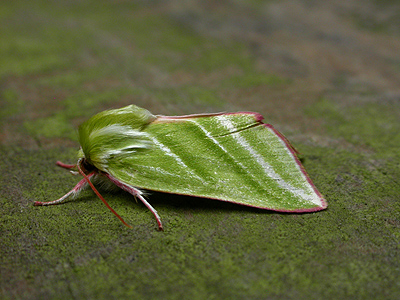 |
|
| ... | ||
| Those species recorded in the highest numbers included 223 Diarsia mendica Ingrailed Clay, 221 Agrochola macilenta Yellow-line Quaker, with 107 recorded just in 1987 alone, 197 Conistra vaccinii Chestnut, 188 Xestia xanthographa Square-spot Rustic, 179 Cosmia trapezina Dun-bar, 127 Rusina ferruginea Brown Rustic and 119 Oligia fasciuncula Middle-barred Minor. All these species are still proportionally common compared to all other species and confirmed in recent years via trapping sessions with a 125W MV light. |
| ... |
| 1986 | 1987 | 1988 | 1989 | 1990 | Total | ||
| 73.348 ... 2111 ... Noctua janthe Lesser Broad-bordered Yellow Underwing | |||||||
| Nolidae | |||||||
| 74.003 ... 2077 ... Nola cucullatella Short-cloaked Moth | 00 | 00 | 3 | 00 | 5 | 8 | |
| 74.007 ... 2421 ... Bena bicolorana Scarce Silver-lines | 00 | 00 | 00 | 00 | 00 | 00 | |
| 74.008 ... 2422 ... Pseudoips prasinana Green Silver-lines | 1 | 2 | 1 | 00 | 00 | 4 | |
| 74.009 ... 2423 ... Nycteola revayana Oak Nycteoline | 00 | 00 | 00 | 00 | 00 | 00 | |
|
Nolidae summary Just two out of the four members from the Nolidae family were recorded within the Rothamsted survey's five years of operation (for which we have the data for) between 1986 and 1990. A total of eight Nola cucullatella Short-cloaked Moth, meant that it was quite easily the commonest of the two species recorded, with records only in 1988 and 1990. It was well recorded during the 1980's, but then (probably through lack of regular trapping) went missing for a number of years, but did turn up again in 2008 and 2009. Pseudoips prasinana Green Silver-lines has always been fairly regularly recorded at Sherwood Forest and from recent records, still seems so today. Neither Bena bicolorana Scarce Silver-lines or Nycteola revayana Oak Nycteoline turned up, even though Scarce Silver-lines has always been quite regular at Sherwood, including during the 1980's, but just not in the Rothamstead trap. Oak Nycteoline on the other hand has undergone a post-2000 range increase in Nottinghamshire. Sherwood Forest recorded it's first in 2008, when it became virtually annual until 2014 and probably still remains so. |
| ... |
| Photo Galleries index page |
| Moths |
| Homepage |